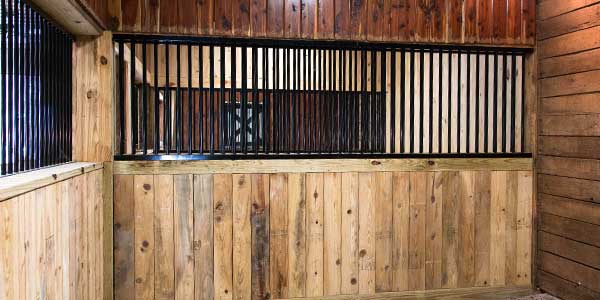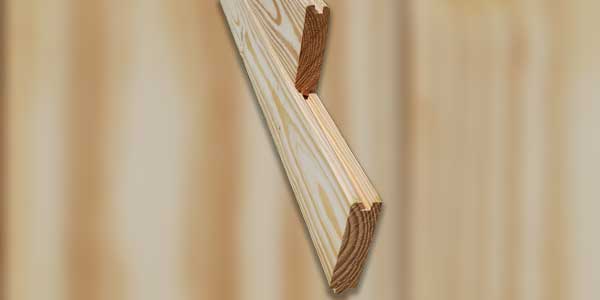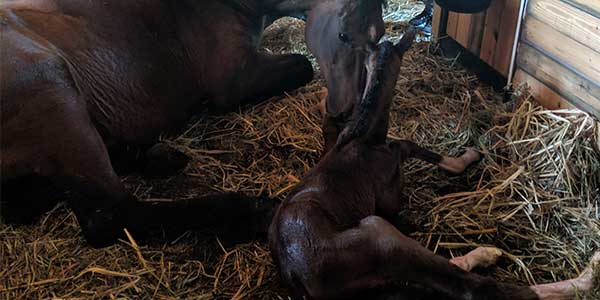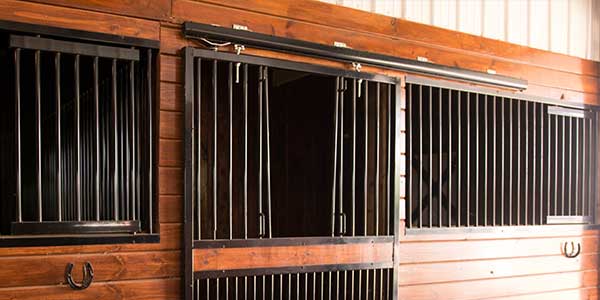What is the Best Size for Horse Stalls?
What are the ideal dimensions for a safer horse stall?
The most common horse stall sizes are 10'x10', 10'x12', and 12'x12'. To make the best use of your back space, you will want to carefully measure your allotted space to determine the size of each stall. It is not recommended to have more than one horse in a stall for safety concerns, however, if you were to do so the horse stall size should at least be 16'x16'.
Please keep in mind, your horse's stall is actually a small room. Consider sidewalls (partitions), back walls, and window grills when planning your horse stall layout.

- Stall Walls – Grilled partitions promote good airflow, as well as allowing horses to socialize.
- Window Grills – Ventilation is absolutely critical when designing horse stalls. To properly measure your window space, use the inside dimensions.
Lumber Recommendations
We recommend installing horse stall walls and doors with 2x6 tongue and groove southern yellow pine wood boards. These boards lock together, thus giving your stalls more strength by dissipating any force. The face of each board totaling 5" in height.
We also recommend installing treated boards for the bottom 2-3 boards because shavings will crown onto the bottom of your stalls.

You can either purchase the wood locally to save on freight costs or from RAMM upon request.
Preparing for Foals
Due dates are an important thing to know, according to Jeannie Strain of Strains' Thoroughbreds in Swanton, OH. Of course, due dates are never set in stone. Many a mare-owner, have been greeted with a lovely surprise when going out to feed in the morning. However, a due dates help gauge for when final preparations for the birth should be made by.

- If you are moving your mare into a foaling stall, put her in at least a week ahead of time to allow her to get used to her new home. Be especially vigilant when checking to make sure there is nothing in the stall for the foal to get caught on. For example: a gap between boards a mare would not be able to get a leg through may be wide enough for a baby's spindly legs. The bars in the grillwork should be spaced close enough to prevent a baby from getting his head or a leg caught.
- If a wall has been removed to turn two stalls into one big birthing stall, make sure all the edges are smooth. Check for gaps under doors and feel for drafts. Tarps can be hung to prevent drafts. Make sure that any baling twine used to secure the tarp is out of reach so that it doesn't get chewed through or tripped over.
- Check your foal monitor to make sure it's working, and have a first-aid kit that has been approved by your veterinarian. Also, make sure you have your vet's phone number handy. Keep a flashlight, extra batteries for the flashlight, your phone, and a two-way radio as back up to your phone all on hand.
- Have plenty of straw available. Even if you normally use shavings for bedding, use straw for your foaling stall. Straw isn't as dusty as shavings and won't clog a newborn's wet nostrils, says Teresa Angiletta of Angiletta Performance Horses. Teresa is a University of Findlay graduate with degrees in Equine Studies and Equine Business Management. Straw also won't stick to the umbilical cord.
- If your baby is coming early in the year, see if your veterinarian wants you to use a heat lamp. A well-ventilated stall may be all that's recommended. If you do use heat lamps, check with an electrician to make sure it is in working order and that your barn's wiring can handle it. If you will be blanketing your baby, make sure the blankets are clean and will fit properly. Foal blankets have many places where their size can be adjusted.
- Make sure your stall floor is even and level. Fill in all pits and holes. While some breeders think mats are too slippery for a baby to get a good grip on his first try to stand, a good textured mat made specifically for horses with a deep straw bed will probably be just right. Mats in the aisle allow for good footing there, too.
- Clear aisle ways so there's nothing for baby to trip over or run into on his first trip outside.
Feeding Functionality
To save yourself time in the long-run and to make feeding easier, include feed doors, feed openings, and/or other horse stall feeders and hayracks.

For feed rooms, it's best to utilize solid sliding stall doors that can be locked to control access.
*Please note: these are just a few tips; contact us if you have any additional questions.
